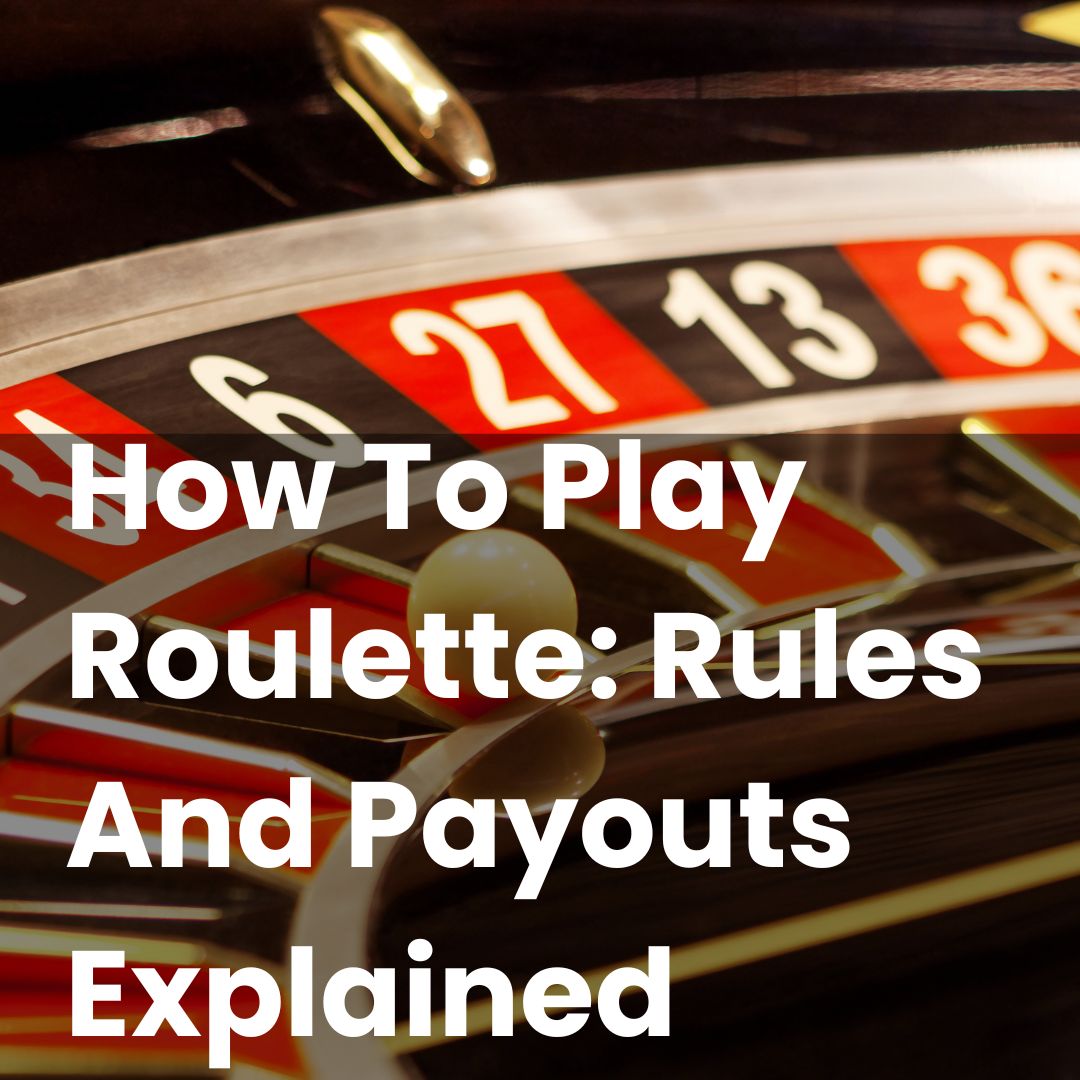For those new to roulette, the game may seem complex at first, but it follows a straightforward set of rules. The wheel contains numbered pockets, and a small ball is spun around it before landing in one of them, determining the winning outcome.
If you’ve seen roulette before but never fully understood how it works, this guide provides a clear explanation. As you read on, you’ll gain a better understanding of the game, its mechanics, and what to expect if you decide to play.
What Is Roulette?
Roulette is a popular game found in many casinos. The game revolves around a wheel, a ball, and a table with various numbers and betting options.
The wheel has numbered pockets from 0 to 36. In European roulette, there is a single 0, while American roulette includes an additional double 0. Players place bets on the table and try to predict where the ball may land once the wheel is spun and stops.
There are different types of bets on the table. These include betting on single numbers, groups of numbers, odd or even numbers, and the colours red or black. Each type of bet has its own potential payout.
Once bets are placed, the dealer spins the wheel and releases the ball. The ball eventually lands in a pocket, determining the outcome of the game.
It’s important for players to remember that each spin is independent of the previous one. All players should gamble within their limits and keep in mind the importance of responsible gambling at all times.
When Was Roulette Invented?
Roulette traces its origins back to 18th-century France. It is believed to have been invented by the French mathematician Blaise Pascal, who was attempting to create a perpetual motion machine. The game evolved over the years and took on its modern form during this period.
The name “roulette” is French for “little wheel.” By the late 1790s, the game of roulette was being played in Paris in the way that many recognise today. Players were placing bets on numbers and colours on a roulette table, much like they do in casinos nowadays.
Over time, the game spread beyond France and became popular in other parts of Europe and the United States. While European roulette features a single zero pocket, the American version introduced a double zero, adding a distinct twist to the gameplay.
As roulette evolved, various strategies and betting systems emerged, although all players should be reminded that roulette, like all gambling, should be approached responsibly. Each spin remains a matter of chance, and players should always be aware of their limits.
Discover The Best Online Casinos
Browse our list of top-recommended casino sites, read reviews from real players & be the first to get access to the latest casino bonuses
How Are Roulette Machines Programmed?
Roulette machines, often known as electronic roulette, work a bit differently from traditional roulette tables. Instead of a physical wheel and ball, these machines use software to simulate the action.
The key component in these machines is a Random Number Generator (RNG). The RNG produces random number sequences, which determine where the virtual ball lands on the wheel. This ensures fair and unbiased results, with each round being independent of the last.
Manufacturers must ensure their machines comply with strict industry standards and regulations, such as those set by the UK Gambling Commission (UKGC). This compliance helps maintain fairness and transparency within the game.
It’s important for players to remember that, just like traditional roulette, the outcome is always random. Players should approach electronic roulette with the same sense of responsible gambling, keeping in mind their personal limits and intentions while playing.
How Many Roulette Types Are There?
Roulette comes in a few different variations, each with its own unique layout and rules. Understanding these may help players decide which type they might prefer when exploring options at a casino.
The three main types of roulette are European, American, and French. Each of these offers a different experience, primarily based on the structure of the wheel and table layout.
European roulette is perhaps the most common version encountered, especially in online casinos. American roulette, on the other hand, features an additional double zero pocket, which slightly changes the dynamics of the game.
French roulette shares similarities with the European version but has a few distinct rules and betting options that some players may find appealing.
European
European roulette is a popular version of the game that players might encounter both online and in land-based casinos. Its wheel features 37 pockets, numbered from 0 to 36. The presence of a single zero distinguishes it from its American counterpart, which includes an additional double zero pocket.
The layout of the European roulette table is straightforward, allowing players to place a range of bets. These bets can be on individual numbers, groups of numbers, or categories like odd, even, red, or black. Each type of bet has its own potential payout.
Players interested in European roulette should take time to familiarise themselves with the betting options and rules. Remembering to gamble responsibly and staying within personal limits ensures a more mindful gaming experience.
American
American roulette is one of the well-known variations of the roulette game. It is regularly found in casinos, particularly in the United States.
The American roulette wheel has 38 pockets, which include numbers 1 to 36, a single zero (0), and a double zero (00). This extra double zero pocket differentiates it from the European version of the game.
The layout of the table in American roulette is designed to accommodate the additional double zero, influencing the probabilities and potential payouts for certain bets. Players might notice this when comparing it to other roulette types.
French
French roulette is a classic version of the game and shares a similar wheel layout to European roulette. It features 37 pockets, numbered from 0 to 36, with a single zero.
What sets French roulette apart are its unique rules and betting options. The “La Partage” rule is a well-known feature. If a player places an even-money bet, like red or black, and the ball lands on zero, they may receive half of their stake back.
Another distinctive element is the “En Prison” rule. In this scenario, if the ball lands on zero and a player has made an even-money bet, the bet might be held “in prison” for the next spin. If the player’s bet wins on the following spin, their stake is returned.
The betting layout on the French roulette table may appear different due to the use of French terms and additional betting options. Players may want to take time to familiarise themselves with these unique rules and layout to enhance their understanding.
What Are The Rules of Roulette?
Roulette is a straightforward game with a few basic rules that players should understand before starting. At its core, roulette involves trying to predict where a ball will land on a spinning wheel. European and French wheels contain numbered pockets that range from 0 to 36, with the American version including an additional double zero.
Players start by placing their bets on a table that corresponds to the numbered wheel. They have a variety of betting options, such as choosing a single number, a group of numbers, or broader categories like red, black, odd, or even.
Once all bets are placed, the dealer spins the wheel and releases the ball. Players must wait to see which pocket the ball lands in to determine the outcome. Those who have placed their chips on the correct number or category will receive a payout according to the bet they made.
Placing Bets
When it comes to placing bets in roulette, players have a range of options available to them. Understanding these choices can make participation clearer and more straightforward.
Bets are placed on the table layout, which corresponds to the numbers and sections of the roulette wheel. Players can choose between “inside bets” and “outside bets.” Inside bets refer to specific numbers or small groups of numbers. These may include a single number, two numbers that are adjacent (a split bet), or three numbers in a row (a street bet).
Outside bets cover larger sections of the table and may include categories like red or black, odd or even, and larger groups of numbers such as dozens or columns. These bets usually carry different potential payouts compared to inside bets.
Each player has chips that are distinct in colour, allowing them to differentiate their bets from others. Bets must be placed before the dealer signals the end of betting and spins the wheel.
It’s important for players to familiarise themselves with these betting options and consider their choices carefully. Setting personal limits is a sensible approach, ensuring that the game remains a purposeful and mindful activity.
Wheel and Table Layouts
Roulette features two key components: the wheel and the table layout. Both are integral to understanding how the game functions.
The roulette wheel is divided into numbered pockets. In European roulette, there are 37 pockets, including a single zero. American roulette adds a double zero, increasing the total to 38 pockets. The numbers are arranged randomly around the wheel, alternating in colour between red and black, with zeros typically being green.
The table layout is where players place their bets. It mirrors the arrangement of numbers on the wheel, allowing for a variety of betting options. These include inside bets, such as betting on a single number or a combination of numbers, and outside bets, like red or black and odd or even.
Players may want to familiarise themselves with both the wheel and table layout to understand how their bets correspond to the numbers on the spinning wheel. Being aware of the different sections and betting areas can help players make more informed decisions.
Bet Variations
Roulette offers a range of bet variations that may suit different preferences. Becoming familiar with these options may help players decide how they might want to place their bets.
Inside bets focus on specific numbers on the roulette table. Players might choose a straight-up bet on a single number. Alternatively, they could consider a split bet, covering two adjacent numbers by placing a chip on the line between them. Other options include street bets, which cover three numbers in a row, and corner bets, which include four numbers forming a square.
Outside bets provide broader coverage on the table. These might involve wagering on larger groups such as red or black, odd or even, or high (19-36) or low (1-18) numbers. Column and dozen bets cover 12 numbers at a time, providing additional choices.
Each bet type has different potential payouts. Players are encouraged to understand these variations and consider their approach carefully. It’s essential to practice responsible gambling and ensure that limits are respected while playing.
Roulette Odds and Payouts Explained
Understanding roulette odds and potential payouts may be of interest to those looking to engage with the game. Each type of bet has its own odds and corresponding potential payouts.
Inside bets focus on specific numbers or small groups of numbers. For instance, betting on a single number, known as a straight-up bet, has higher odds and, therefore, might offer a greater potential payout. Other inside bets, like splits and corners, cover more numbers but come with different odds and payouts.
Outside bets, on the other hand, cover larger sections like red or black and odd or even. These bets typically have better odds but lower potential payouts compared to inside bets. These options might appeal to those who prefer the chance of more frequent—but smaller—potential wins.
It’s important for players to remember that while understanding odds and potential payouts is valuable, winning is never guaranteed. Players are encouraged to gamble responsibly, keeping their personal limits in mind at all times.
House Edge
Understanding the house edge is beneficial to those who want to know how roulette works. The concept refers to the advantage the casino has over the player over time.
In European roulette, the house edge is approximately 2.7%. This is due to the presence of a single zero on the wheel, which slightly tilts the odds in favour of the casino.
American roulette, with its additional double zero, has a higher house edge of around 5.26%. The extra pocket increases the number of outcomes, giving the casino a larger advantage compared to the European version.
French roulette also has a single zero, similar to the European version. However, thanks to rules like “La Partage” and “En Prison,” the house edge may be reduced even further on even-money bets.
European, American and French Roulette
Roulette comes in three main variations: European, American, and French. Each type has distinct features that influence the game dynamics and potential payouts.
European roulette is perhaps the most commonly played version. It features a wheel with 37 pockets, numbered from 0 to 36. The inclusion of a single zero allows for slightly better odds for some bets compared to its American counterpart.
American roulette, with 38 pockets, includes both a single zero and a double zero. This addition may affect the potential payouts, as the house edge is higher compared to European roulette. Players might notice this when placing certain bets.
French roulette, while similar to European roulette with its single zero, introduces unique rules such as “La Partage” and “En Prison.” These rules may influence potential payouts on even-money bets and add an extra layer to the gameplay.
What Is The Most Successful Roulette Strategy?
When discussing roulette strategies, players might wonder if there is a method that guarantees success. It is important to note that roulette, at its core, is a game of chance. Each spin is independent, and outcomes are random, so no strategy can assure a win.
Players might come across various strategies, such as the Martingale, Fibonacci, or D’Alembert systems. These strategies often focus on how to adjust bets in response to wins or losses, but they don’t change the odds of the game itself.
While some players might find using a strategy to be an interesting way to engage with the game, it is crucial to remember that results will always be unpredictable. The primary aim should be to approach roulette with awareness of personal limits.
Martingale
The Martingale strategy is often mentioned in discussions about roulette. It is a betting system that focuses on the idea of doubling the bet after a loss, with the goal of recovering previous losses with a single potential win.
Players using the Martingale strategy typically place an even-money bet, such as red or black. If they lose the bet, they double their stake on the next round. The hope is that if they win, they will recover all the previous losses plus a profit equal to the original bet.
While the Martingale strategy might seem straightforward, it requires a player to have a substantial bankroll to cover multiple losses in a row. Additionally, casinos often impose table limits, which might prevent players from doubling their bets indefinitely.
For anyone considering the Martingale strategy, it is important to stay mindful of personal limits and the nature of the game, as roulette remains a game of chance. Players should always remember to gamble responsibly and understand that no strategy guarantees a win.
Fibonacci
The Fibonacci strategy is another system some players explore when playing roulette. It is based on the famous Fibonacci sequence, where each number is the sum of the two preceding ones, starting with 1 and 1.
In the context of roulette, players usually apply this sequence to their betting. They begin with a low stake and move forward in the sequence after a loss. This means if they lose, their next bet would be the sum of the last two stakes. If they win, they step back two numbers in the sequence.
The Fibonacci system is often used on even-money bets such as red or black and odd or even. These kinds of bets have a closer probability of winning and losing, fitting the method’s step-by-step nature.
It’s important for players using the Fibonacci strategy to be mindful of their bankroll and the table limits, as the stakes may increase after consecutive losses. As with all strategies, this method does not guarantee a win, so players should always gamble responsibly, bearing in mind their personal limits.
Labouchere
The Labouchere strategy, also known as the cancellation or split Martingale system, is a method some players use when playing roulette. This strategy is a bit more complex compared to others like the Martingale or Fibonacci.
To start, a player determines how much they aim to win and splits this amount into a sequence of smaller numbers. For example, if they wish to win £10, they might choose a sequence like 1, 2, 3, 4. Each number in the sequence represents a unit of their bet.
For each round, players bet the sum of the first and last numbers in their sequence. If the bet is successful, they remove those numbers from the sequence. If the bet doesn’t win, they add the amount they just bet to the end of the sequence.
The aim is to remove all numbers from the sequence, signifying the target win has been achieved. However, like all strategies, the Labouchere does not change the odds of the game.
Players are encouraged to understand the structure and limits of their bankroll, as sequences can grow if multiple bets are not successful. Keeping responsible gambling principles in mind remains important when exploring such strategies.
D’Alembert
The D’Alembert strategy is another method that some players use when playing roulette. It is simpler than some other strategies and is based on balancing wins and losses over time.
The D’Alembert method involves increasing a bet by one unit after a loss and decreasing it by one unit after a win. The aim is to keep the betting level steady, with the hope that a series of wins and losses might balance out over multiple rounds.
This strategy is often applied to even-money bets, such as red or black, because these bets have close probabilities of winning and losing. However, like all strategies, it does not alter the game’s odds and winning can never be guaranteed.
Players considering the D’Alembert system should keep in mind the importance of managing their bankroll effectively. While the strategy might appear more controlled than some others, the outcome of each spin remains uncertain. It’s always essential to practice responsible gambling and ensure personal limits are respected.
Paroli
The Paroli strategy is a betting system that some roulette players explore. Unlike other strategies, it is often considered more positive in approach, as it involves increasing bets following a win rather than a loss.
At the core of the Paroli strategy is the idea of doubling bets after each win, with the goal of achieving a series of consecutive wins. Players usually start with a base bet and double it for a set number of wins, often three, before returning to the base bet. If they encounter a loss, they revert to the original bet.
This strategy is mainly applied to even-money bets like red or black, and odd or even. These bets balance the chances of winning and losing, which fits the nature of the Paroli system. However, it’s important to keep in mind that wins are not guaranteed when using this system, as with all betting systems.
While utilising the Paroli strategy, players should remain mindful of their budget. The strategy relies on achieving multiple wins in a row, which doesn’t change the odds. It’s essential to practise responsible gambling and keep enjoyment and limits in balance while at the roulette table.
Which Variation of Roulette Is Best To Play?
When considering which variation of roulette might be best to play, it’s essential to recognise that there is no universally “best” version. The choice often comes down to personal preference and what a player might find appealing.
European roulette typically presents a lower house edge at about 2.7%, thanks to its single zero. This single zero pocket might make it more appealing to those looking for marginally better odds.
French roulette, offering similar odds to European roulette, introduces unique rules like “La Partage” that might be engaging for those who appreciate strategic variations.
Ultimately, players should consider their gameplay preferences and what aspects of each variation they value most. Regardless of the version chosen, it’s crucial for players to practise responsible gambling and maintain awareness of their limits while enjoying the game.
Play at The Best Online Roulette Casinos
For those considering enjoying roulette online, selecting the right platform is an important step. With many online casinos available, choosing a reputable site licenced by the UKGC is key to ensuring a fair and enjoyable experience.
On our website, there is a dedicated page that showcases the best online casino sites for playing roulette. This carefully curated list features casinos that offer great options for those interested in exploring the game.
These platforms are recognised for maintaining strong security measures and providing a variety of roulette games. Players might find these options useful as they decide which type best suits their interests.
It’s important for players to approach online gambling thoughtfully, maintaining awareness of their personal limits. Those interested can explore our recommendations to find a suitable casino that meets their needs. Remember to always engage in responsible gambling practices.
Roulette FAQs
How Many Numbers Are on a Roulette Wheel?
The number of pockets on a roulette wheel depends on the version of the game. European roulette has 37 pockets (numbers 1 to 36 plus a single zero), while American roulette has 38 pockets (including an additional double zero (00)).
The extra pocket in American roulette increases the house edge, making it slightly less favourable for players compared to European roulette.
Is Online Roulette Rigged?
Licensed online roulette games are not rigged, as they operate using RNGs to ensure fair and unpredictable results. UK online casinos are regulated by the UKGC, which enforces strict fairness standards. Players should always choose UKGC-licensed casinos to ensure the game follows industry regulations and is independently tested for fairness.
How To Win Roulette Every Time?
There is no guaranteed way to win every time in roulette, as it is a game of chance with random outcomes. While some players use betting strategies, such as the Martingale system, these do not change the house edge or guarantee consistent wins. The best approach is to play responsibly, understand the odds, and set limits to ensure a balanced gaming experience.
What Do All The Numbers on a Roulette Wheel Add Up To?
When you add up all the numbers on a standard European or American roulette wheel (1 to 36), the total is 666. This sum is purely a mathematical coincidence and has no effect on gameplay. Regardless of the number sequence, each spin remains independent and random, ensuring that no number is more likely to appear than another.





